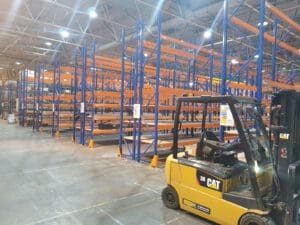
Advanced Handling & Storage Ltd
The Pallet Racking People

If you are considering building, or moving into, new warehousing, one of the first considerations has to be the pallet racking. What is the right type for the inventory that you are going to store? Getting the planning right is crucial for the most cost-effective operation of the warehouse.
Basic pallet racking consists of upright steel frames which are connected by horizontal steel beams. Two frames and the appropriate beams constitute a bay and the pallets rest on the horizontal beams. Simple, yes?
Well, yes and no.
Obviously the number of pallets that can be stored in a bay depends on how high the frames are and the number of beams. The average height of a frame is between 20 and 25 feet, but high rise systems can go up to 100 feet. The upright frames have cross braces to hold them together and these may be horizontal or diagonal or a mixture of both. They can be either welded together or bolted together. In the UK the bolted method is preferred.
A similar option is applied to the crossbeams which can be bolted to the frames or alternatively connected using a system of slots.

Low And High Density
There are also two different pallet racking systems which can be described as low density systems or high density. Low density offers the easiest access to the inventory, while high density makes a better use of the space available but reduces the ease of access to the inventory. Let’s take a look at the various options.
Low density rack can be of “single deep” proportions and is the most common type of pallet racking. As you would expect from the name, this provides racking one pallet deep from the front of the rack and is the easiest to access. However, it also requires more aisles than other racking systems, since each aisle can only accommodate one pallet rack on either side. Any type of forklift can be used. This is also the cheapest form of pallet racking, but takes up a greater square footage of the warehouse space.
A low density rack can also be of “double-deep” proportions, which simply means that one pallet can be stored behind another. If the pallets can be stored on a “first in/last out” basis this will be fine, and it reduces the number of aisles needed. However, in order to reach the rear pallet a long reach fork lift will be required and, of course, the front pallet will need to have been removed.
Drive In Rack
The next type of pallet racking is the “drive in” rack. This can be designed to hold loads of four or more pallets deep and is a high density form of racking. The forklifts drive into the bay and place the first pallets at the rear of the bay and then reverse out. The rack does not have the usual cross beams, and the pallets are stored on rails running along the inside of the bay. Pallets could be stored four high and five deep – or even more. For obvious reasons this works on a “last in/first out” basis which is fine if a whole bay of product is to be removed and shipped at the same time.
A variation of the “drive in” pallet racking is the “drive through” version. It is similar, but means that the bay can be accessed from either end. Obviously, another aisle is needed but it means that pallets can be loaded from one end and removed from the other which in turn means that pallets can be stored on a “first in/first out” basis.
Flow Racking
If you are storing products which are dated you can use a flow rack system. Pallets are loaded into the rear end of the rack on to a type of roller conveyor which then travels down a slight incline so that they can be removed from the other end. Flow rack systems are usually used for single products.
As you can see, there are a number of different ways in which to configure pallet racking in your warehouse in order to make the best use of the available space and provide the best solution for your business. It is not something to be rushed, so you need to sit down with your chosen pallet racking supplier and work out the most efficient way of storing your products before onward transport to your customers.
Get in Touch with Advanced Handling & Storage
If you want to maximise your warehouse space through the use of second hand or new pallet racking, please don’t hesitate to get in touch with us on 0800 345 7088 or send an email to [email protected]
Make sure you follow #TeamAdvanced on Social media for all our latest news and offers.
Like us on Facebook
Follow us on Twitter
Connect with us on LinkedIn
Subscribe to Our YouTube channel
Follow us on GooglePlus
Read our other blogs on Medium
Follow us on Instagram